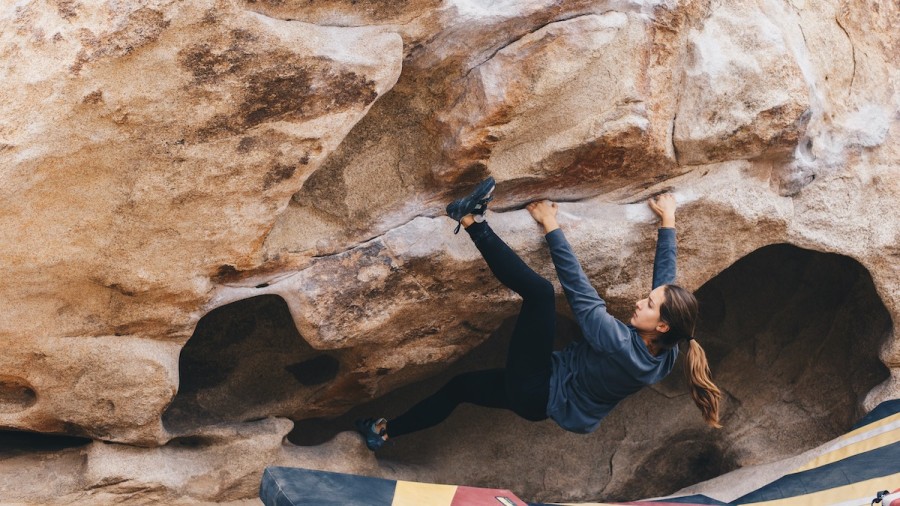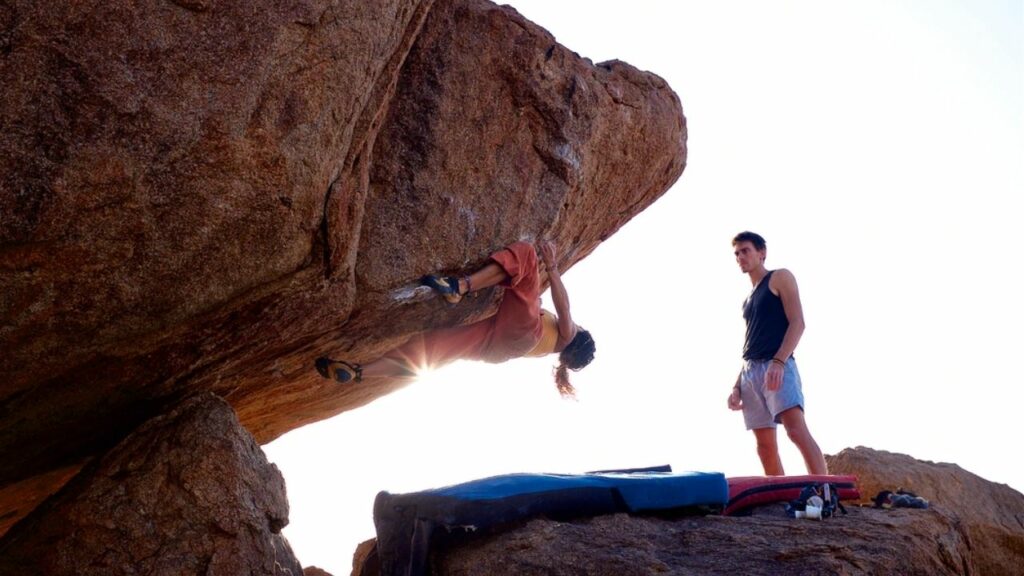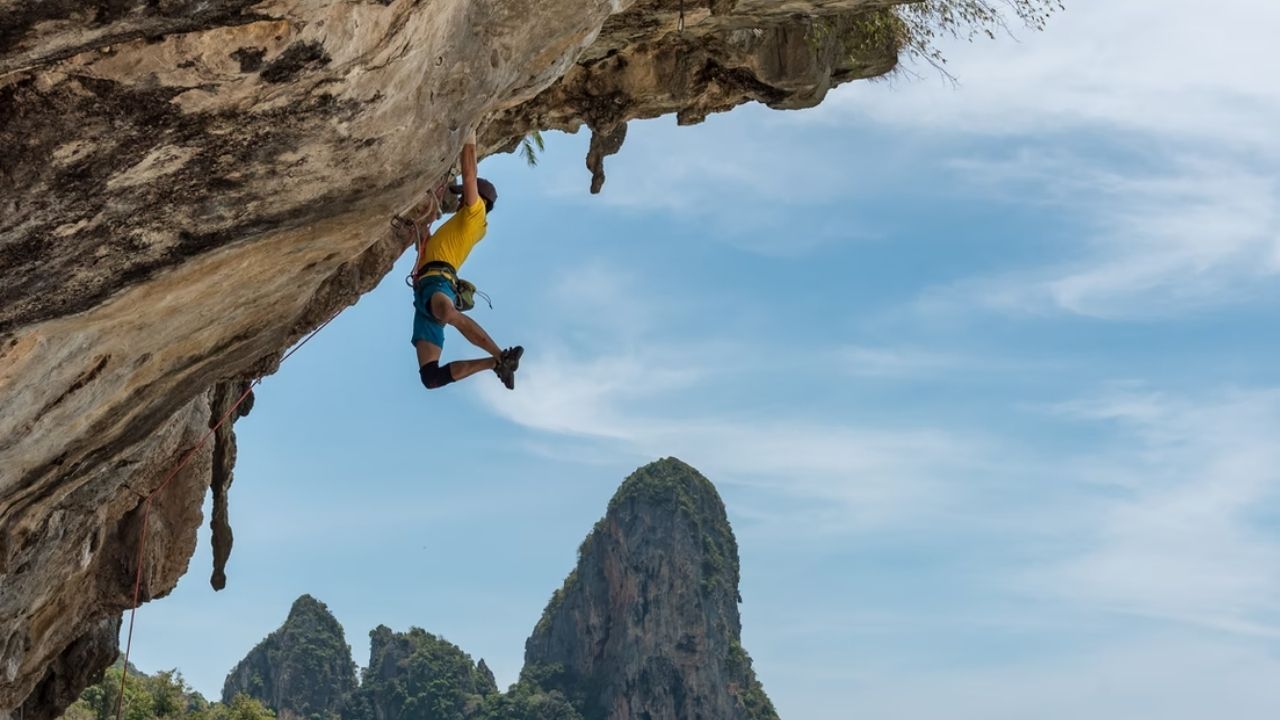Fear is a natural human response to stressors and perceived danger. Sometimes though, irrational fear can falsely trigger our body’s fight-or-flight response. This defense mechanism was a clutch for our ancient ancestors, but for us, it can be counterproductive.
Phobias like the fear of falling when climbing is a great example. Ring any bells? Don’t worry, you’re not alone. There are plenty of climbers that have re-trained their minds to conquer the fear of death-defying heights while climbing, bouldering, and mountaineering.
Even I still get chills and thrills if I’m climbing high enough to fall a great distance. And I’m what many would call a lifelong climber. Luckily though, the fear of falling isn’t innate. Rather, it’s a survival mechanism learned during development. This means you can overcome the phobia on your own!
Just consider this – a group of scientists once researched newborn babies between 0-9 months. First, infants (about one month) were put on a see-through glass table. Surprisingly, almost all of them were excited looking at the ground below. But by 9 months old, thy fight-or-flight response was triggered.
Point is, you can rewire your brain if you’re dedicated!
In this article, I’ll teach you how to embrace the heart’s pumping action as well as proven mind hacks to reach new heights.
Can you rock climb if you’re scared of heights?
I’m willing to bet that you’re not actually afraid of heights. Hear me out…
Most humans have self-diagnosed acrophobia (irrational fear of heights), but we actually have basophobia (irrational fear of falling). Simply put, you’re not afraid of standing on the roof but falling off it.
Unlike acrophobia, basophobia is more experience-based and easier to break. Let’s see how.

1. Learn and Understand Your Fear of Falling to Manage It.
Fear isn’t absolute – it comes in varying degrees based on various situations. A sense of danger is an essential part of climbing survival.
Ideally, you should learn to manage your fears – it’ll indicate the moves you can and cannot make. Fear also communicates when you’re at your limit and you have to bow out.
Managing your fears begins with understanding them – is it a real or perceived fear? Have you ever been involved in a height-related incident? Or is your basophobia a natural instinct?
Perceived fear is most common. Many adventurers overcome their fear of heights/falling after paragliding or skydiving.
Ask yourself what exactly are you afraid of – physical injuries, mental injuries, or something else entirely? Reach the root of the problem.
2. Confront Your Fear of Falling to Overcome It.
The golden rule: you must go rock climbing if you want to overcome your fear. Confronting your irrational fears is the tried-and-tested method of breaking unwanted phobia.
Obviously, you don’t need to go headfirst. Before we learn how to drive, we learn basic traffic rules and abstract car mechanisms. The same basics apply here – learn how to fall. Practice falling repeatedly until it becomes second nature.
If you’re still skeptical of climbing, this should prove that it’s just a natural human tendency:
How to get over your fear of falling and climb safely?
The only way to master your fear of falling to climb safely is by falling properly and consistently. It’s a challenging process that could break your self-induced phobia. First, understand the root cause of your fear, learn how to fall properly, and practice.
Here are some tips that will help you overcome your fear of climbing:
- Start small and safe with indoor climbing.
No need to go bouldering outdoors just yet. Join a climbing gym instead – learn the nuances. Schedule regular climbs at the gym. Create a goal and stick with it for the next 3 months.
- Learn how to fall immediately.
After you’ve learned the basics, become a regular gym-goer to prioritize learning to fall.
- Hone the art of falling.
Fall every chance you get to dodge bullets in the future.
- Push yourself, but not “too far.”
Since you’re new to climbing, it’s important to learn your body and push your limits but only to a certain extent..
Rule of thumb: when it starts becoming uncomfortable, let go and fall right in front of you, especially when you’re not in a perfectly stable position.
- Learn to trust your safety gear.
When practicing fall techniques, consider how your safety gear (helmet, pads, belay devices, harnesses) is doing its job. Developing that trust will alleviate the fears associated with incremental progress.

- Build a body you can depend on.
Oftentimes, a lack of confidence in our bodies is a part of the irrational fear of falling when climbing. Spend ample time training your body, including cardio and lightweight strength training, to build your muscles.
- Practice your breathing.
Breathing exercises are important for all stamina sports including climbing.
- Don’t climb in the open.
I recommend starting with dihedral climbs. Our brain interprets walls as a safe areas. The vertical climb can be nerve-wracking because it is often exposed.
- Join the community.
Surrounding yourself with trustworthy peers alleviates fear in humans.
Bonus Tip: Just Keep Falling.
Keep repeating and confronting the phobia to break it. It’s your survival training.
How do you fall while rock climbing?
Ideally, push and jump away from the wall to fall while rock climbing. The farther you go from the wall, the longer the rope will stretch. This increases your slowdown time.
The slowdown time is the time difference between when the rope starts to stretch and when you come to a complete stop after a fall. More slowdown time equals softer, safer falls. That’s why many climbers say, “big whippers are better than small falls.”
Now, for the falling technique!
First off, here are helpful falling tips for all types of climbing:
- Take a deep breath before jumping. Synchronize your breathing to avoid choking up.
- Don’t stiffen your muscles up. Relax your muscles to absorb the impact properly.
- Get into the ideal falling position by bending your knees and feet slightly.
- Higher falls are scarier. So, when starting your falling practice, start from a shorter height distance.
1. How do you fall when top-roping?
Start with a smaller slack to limit the fall distance. 3 feet is ideal, to begin with. Once you have reached the designated mark, simply let go by pushing backward.
Always practice your smalls in sets and increments. So, fall 3 times like we discussed, then move upward. Once you’ve familiarized yourself, try bigger falls – ask your belay partner to give you 6ft and 10ft of slack, respectively, between adequate sets.
After that, get creative. Try things that scare you, forcing yourself to put more and more trust in your safety gear.
2. How do you fall when lead climbing?
Falling from lead climbing is identical to the one from top-roping with a minor difference – the fall is much shorter since you’re clipped closely above yourself.
Try this in sets. When you get bored, start clipping sideways before falling to identify and get comfortable with various angles.
Finally, try a simple dynamic exercise – once you trust the system, aim for the next hold and make a move. You can jump, pull, or push whichever you want – the idea is to at least touch the next hold before falling. This teaches the body to relax and not be stiff.
3. How do you fall when bouldering?

Bouldering is the trickiest here because you don’t have any safety gear. Falling repeatedly can cause joint damage even with the proper techniques.
Down climbing is the best way to get off a boulder. Whenever are problem becomes hard to ascend further, start climbing down to reduce the fall distance as much as possible.
Try to even traverse laterally to adjacent easier problems. Downclimbing before falling saves your joints. That said, you’ll still have to fall. Here’s how it’s done.
There are two ways to fall from a boulder – backward and sideways roll.
The setup is the same for both – you fall flat on your feet shoulder-width apart with muscles relaxed and knees bent to absorb the fall. Then jump backward to roll on your back or sideways to roll on your hips.
Never break a bouldering fall with your arms, shoulders, or elbows to avoid fracture.
How often do rock climbers fall?
Climbers fall all the time! Falling is an integral aspect of rock climbing and bouldering. Otherwise, climbing would lose its thrill if you could successfully climb all routes.
I fell 4-5 times last week while trying a new V7 route at my local climbing gym. And if you’re wondering about the fatality rate – the fatality rate of climbing falls is 20 out of 3 million. You have better odds of getting struck by lightning (1 in 700,000)!

